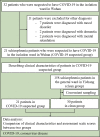Clinical characteristics of hospitalised patients with schizophrenia who were suspected to have coronavirus disease (COVID-19) in Hubei Province, China
- PMID: 32420523
- PMCID: PMC7204789
- DOI: 10.1136/gpsych-2020-100222
Clinical characteristics of hospitalised patients with schizophrenia who were suspected to have coronavirus disease (COVID-19) in Hubei Province, China
Abstract
Background: Since the outbreak of COVID-19, no data have been available for hospitalised psychiatric patients who are suspected to have COVID-19. We performed a comprehensive investigation of the clinical features of hospitalised patients with schizophrenia with or without suspected COVID-19 in Hubei Province, China.
Aim: To explore the clinical characteristics of hospitalised patients with schizophrenia with suspected COVID-19 in Hubei Province, China.
Methods: 21 hospitalised patients with schizophrenia with suspected COVID-19 (COVID-19 suspected group) in the isolation ward of a mental health hospital in Wuhan and 30 hospitalised patients with schizophrenia (clean group) in the general ward of another mental health hospital in Yichang were recruited. We retrospectively reviewed their clinical characteristics, laboratory findings and chest CT results before 21 February 2020. We also compared the emotional and mental symptoms between the two groups.
Results: Medical records revealed that 21 COVID-19 suspected patients were transferred to the isolation ward between 30 January 2020 and 15 February 2020. The mean age (SD) of COVID-19 suspected patients was 43.1 (2.6). 12 (57.1%) patients showed abnormalities on chest CT before onset of respiratory symptoms. 14 (66.7%) patients had psychiatric medications adjustment after detection of abnormal chest CT findings. By 21 February, one patient was confirmed to have COVID-19. Even though the remaining 20 (95.2%) were negative for at least two reverse transcription PCR tests, 11 (52.4%) patients met the diagnostic criteria for clinically confirmed cases. Compared with patients in the clean group, patients in the suspected COVID-19 group showed significantly higher stress, depression and anxiety levels and poorer sleep quality.
Conclusion: Setting up an independent isolation ward for hospitalised psychiatric patients who are suspected to have symptoms of COVID-19 helped control the spread of the epidemic. Patients with schizophrenia suspected to have COVID-19 showed increased stress and mood and sleep disturbances, which should be appropriately managed.
Keywords: cross-sectional studies; epidemiological monitoring; schizophrenia.
© Author(s) (or their employer(s)) 2020. Re-use permitted under CC BY-NC. No commercial re-use. See rights and permissions. Published by BMJ.
Conflict of interest statement
Competing interests: None declared.
Figures
References
-
- Chinese Society of Psychiatry, Psychiatric Hospital Branch of Chinese Hospital Association, Chinese Preventive Medicine Association, Society of Mental Health, Chinese Psychiatrist Association, Chinese Society of Neuroscience & Psychiatry . Expert consensus on managing pathway and coping strategies for patients with mental disorders during prevention and control of serious and outbreak infectious diseases (novel coronavirus pneumonia). Chin J Psychiatry 2020;53.
-
- Chinese Society of Psychiatry, Chinese Psychiatrist Association . Psychopharmacology therapy recommendation for patients with COVID-19. Chin J Psychiatry 2020;53.
-
- Kay SR, Opler LA, Lindenmayer JP. The positive and negative syndrome scale (PANSS): rationale and standardisation. Br J Psychiatry Suppl 1989;7:59–65. - PubMed
-
- Cohen S, Kamarck T, Mermelstein R. A global measure of perceived stress. J Health Soc Behav 1983;24:385–96. - PubMed
-
- HAMILTON M. The assessment of anxiety states by rating. Br J Med Psychol 1959;32:50–5. - PubMed
LinkOut - more resources
Full Text Sources
Miscellaneous


